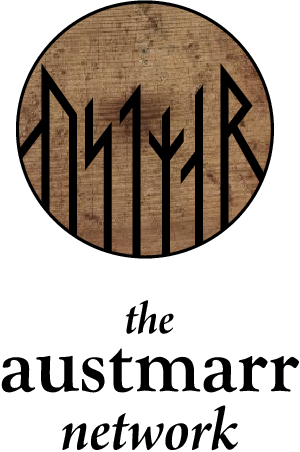About the Austmarr Network
The Austmarr Network is an international, interdisciplinary network of scholars investigating historical and prehistoric contacts among peoples in the circum-Baltic region. We aim to reconstruct the development of the Baltic Sea region, viewed as a trans-ethnic cultural area that played a central role in the emergence of modern Germanic, Slavic, Finnic and Sámi ethnicities. We focus on the pre-Hanseatic period, up to the High Middle Ages. What factors and dynamics shaped the ethnicities now present in the region?
The network arose from recognition of the need to strengthen communication and collaboration across disciplinary and national boundaries. History, archaeology, folklore, philology, comparative religion, historical linguistics, onomastics and population genetics all share an interest in reconstructing the human past, but the methods employed in these different disciplines lead to divergent pictures of the history of the region. We emphasize interaction, networks, fluctuating identities and trans-ethnic communities, as opposed to the predecessors of the modern ethnicities and language groups. In this way, we transcend the limitations of traditional disciplines based on modern languages and nation-states, using models more suited to pre-state societies.
The Baltic region has been populated by humans since the end of the last Ice Age ca. 10,000 years ago. In modern times the Baltic is bounded by the states Denmark, Sweden, Finland, Estonia, Latvia, Lithuania, Russia, Poland and Germany. Both Finno-Ugric languages and the Germanic, Baltic and Slavic branches of the Indo-European family are well represented. Other languages, such as Romani and Classical written langauges, have also had a presence in the region. Areal features in the languages, pre-Christian religions and folkloric traditions of the Baltic region have long been recognized, and the material cultures also show commonalities of many types and ages. The directions of influence are complex and in many cases indeterminate. Nationalism and romantic ideas of national and ethnic identity have historically informed scholarship on the region, including assumptions about the direction of influence, and justifications for modern territories have been an implicit motive.
Understandings of the ways in which languages and populations (separately) move and how ethnoi form and recombine are rapidly evolving. The assumption of stable language areas and the association between aspects of material culture (e.g. pottery styles) and language groups or populations has been questioned. Improved methods in place-name studies and rapid developments in population genetics are providing new data on migrations and prehistoric language shifts. It is high time to revisit the Baltic region in an integrated and systematic way.
The circum-Baltic region, with its rich (pre)history involving several well-studied groups with comparatively deep historical records, provides a robust case study for developing methods that can be applied to other cases of interdisciplinary cultural reconstruction.
The Mediterranean as "mare nostrum" has long been recognized as an area of multicultural, multilingual contacts around an inland sea. Collaborative projects and networks such as the University of California Mediterranean Seminar have recently reexamined the Mediterranean legacy in fruitful ways. We aim to do the same with the Baltic region.
The network has held seven interdisciplinary conferences, in Tartu in April 2011, Helsinki in June 2012, Härnösand in April 2013, Sundsvall in December 2014, Visby in October 2015, Helsinki December 2016, and Tartu in December 2017. The next seminar will be in Stockholm in May-June 2018.
Austmarr logo copyright 2012 by Christopher Sellers, chrissellers.com.
